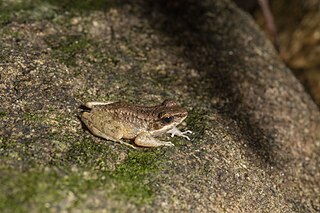Nanorana yunnanensis, commonly known as Yunnan paa frog, Yunnan spiny frog, Bourret's paa frog or Bourret's frog, is a species of frog in the family Dicroglossidae. It is found in southwestern China, Vietnam, Myanmar, northern Thailand, and likely in the intervening Laos. Its natural habitats are small and large streams in montane forests, scrub vegetation and grasslands, and it has also been found in ditches. It is threatened primarily by collection for human consumption, but also by habitat loss caused by agricultural development and infrastructure development.

The Amami tip-nosed frog is a species of frog in the family Ranidae. It is endemic to the Amami Islands, a part of the Ryukyu Islands, Japan. Specifically, it is known from the islands of Amamioshima and Tokunoshima.
Odorrana andersonii is a species of frog in the family Ranidae.
Odorrana anlungensis is a species of frog in the family Ranidae that is endemic to China: it is only known from its type locality, Mount Longtou in Anlong County, Guizhou. Its common name is Lungtou frog or Anlung odorous frog. Little is known about this species found in shaded hill streams 2-3m wide in forested areas.
The Tonkin frog is a species of frogs in the family Ranidae. It is found in northern Vietnam and in adjacent southern China. The specific name is derived from Bac Bo, the Vietnamese name for northern Vietnam, as the species was first described from there.
Odorrana chapaensis is a species of frog in the family Ranidae that is found in southern Yunnan in China and in northern Vietnam. It is likely that it also occurs in nearby areas of Laos.
Odorrana exiliversabilis is a species of frogs in the family Ranidae that is endemic to southeastern China where it is found in Fujian, western Zhejiang, and southern Anhui provinces. These frogs can be found in mountain forest streams and are common in suitable habitat. The species is not considered threatened by the IUCN.

Graham's frog – also known as the diskless-fingered odorous frog – is a species of frog in the family Ranidae. It is found in China and Vietnam. Presumably it is also found in Myanmar in areas adjacent to its Chinese distribution area.

Odorrana graminea, the large odorous frog, inhabits fast-flowing streams in elevated mountainous regions of Southern China and Northern Indochina. It is one of 56 species in the genus Odorrana. Male O. graminea are noted for their ultrasonic call characteristics and are one of three frog species able to detect ultrasonic frequencies, likely evolved to facilitate communication amidst noisy streams and waterfalls. Studies on O. graminea courtship vocalizations suggest female preference for increased proportion of nonlinear vocal phenomena (NLP).
Odorrana hainanensis is a species of frogs in the family Ranidae that might be endemic to Hainan Island, China; there is one record from Guangxi. Prior to its description in 2001, it was confused with Odorrana andersonii.
Odorrana hejiangensis is a species of frog in the family Ranidae that is endemic to China. It is found in the Yangtze River Valley of southern Chongqing and northern Guizhou, with an isolated record in western Guangxi. Its name refers to the type locality, Hejiang County in northern Sichuan. Its natural habitats are shaded hill streams and the surrounding riparian forests. Its status is insufficiently known.
Odorrana jingdongensis is a species of frogs in the family Ranidae. It is known from southern China and northern Vietnam, though it quite likely also occurs in the adjacent areas in Laos and in Myanmar. Its name refers to its type locality, Jingdong Yi Autonomous County in Yunnan. Common name Jingdong frog has been coined for it.
Odorrana junlianensis, also known as the Junlian odorous frog, is a species of frogs in the family Ranidae. It is found in southern China and in the northernmost Laos and Vietnam. Its type locality is the eponymous Junlian County in Sichuan.
Odorrana kuangwuensis is a species of frog in the family Ranidae that is endemic to China. It is found in northeastern Sichuan and northwestern Hubei. Its name refers to the type locality, Mount Guangwu in Nanjiang County, northern Sichuan.
Odorrana lungshengensis is a species of frogs in the family Ranidae that is endemic to China. It is found in northeastern Guangxi, southwestern Hunan, and eastern Guizhou. Its natural habitats are hill streams in broad-leaf forests. It is becoming rare due to habitat loss.
Odorrana morafkai is a species of frogs in the family Ranidae. It is found in eastern Cambodia, southern Laos, and central Vietnam. This frog is highly unusual because it turns from its daytime green color to brown at night.
Odorrana nasuta is a species of frog in the family Ranidae that is endemic to Hainan, China. It occurs near streams in forested regions at elevations of 350–850 m (1,150–2,790 ft) asl. Breeding takes place in streams. It is threatened by habitat loss caused by smallholder farming activities and clear-cutting of forests.
Odorrana orba is a species of frog in the family Ranidae. It is found in southeastern Laos and central Vietnam. The specific name orba is Latin for "orphan", referring to the fact that this species was—at the time of species description—known in Vietnam only from a single juvenile.
Odorrana supranarina is a species of frog in the family Ranidae. It is endemic to Ryukyu Archipelago, Japan, and is known from the islands of Ishigaki and Iriomote, both in the Yaeyama Group. The specific name supranarina refers to the large size of this species —at the time of the species description, it was the largest member of the so-called Rana narina complex. Common name greater tip-nosed frog has been coined for it.

Odorrana utsunomiyaorum is a species of frog in the family Ranidae. It is endemic to Ryukyu Archipelago, Japan, and is known from the islands of Ishigaki and Iriomote, both in the Yaeyama Group. The specific name utsunomiyaorum honours Taeko and Yasuaki Utsunomiya for their contributions to clarifying the amphibian fauna of the Yaeyama Group.





